Are you looking for a way to double your business without spending a ton of money? Do you already offer a good product or service but can’t find a way to jumpstart sales?
I have a story for you…
My name is Ryan Luedecke and I’m the CEO of a beef jerky of the month club called SumoJerky. We handpick gourmet beef jerky for our members and send it to their mailbox, once a month.
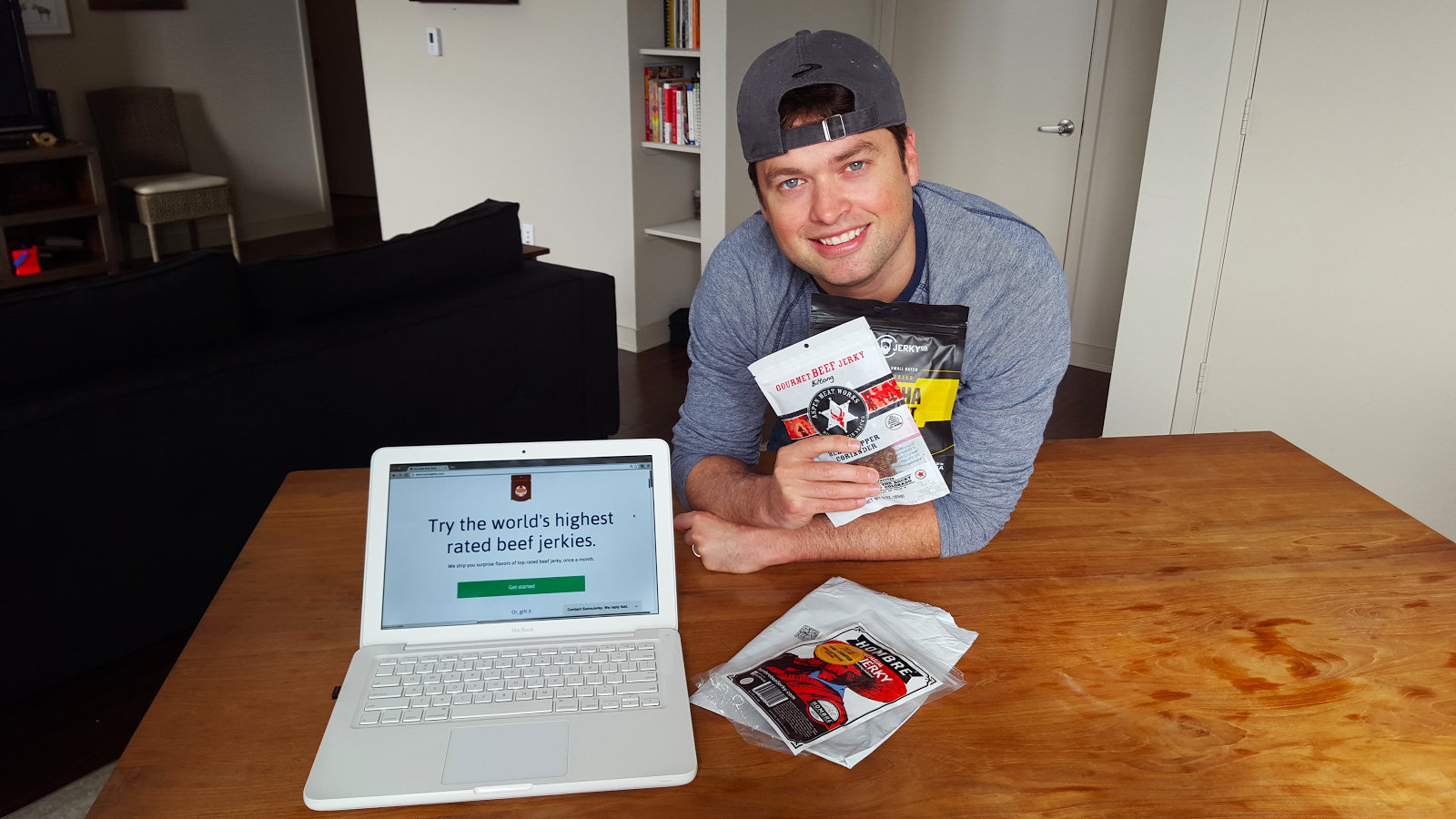
Last year our membership fell from 419 subscribers to 234 subscribers between January and September. That’s a 44% decrease. Ouch.
During that time, my attention and resources were split:
- I attended a 3 month code school which required 60 hours/ week (and $12,000 tuition).
- I took paternity leave to spend time with my wife, Krystal, and our first child, Jacob.
- I did some side jobs for extra income and hatched lots of ideas for new businesses.
While these activities were personally fulfilling, business suffered while I was distracted.
My plan was to let SumoJerky decline naturally while seeking other sources of income to cover my expenses.
My mentor recommended another option: make one last push to grow SumoJerky.
That was September of 2015.
Since then I’ve done five things to save SumoJerky and more than double the subscriber base to an all-time high of 610 members while increasing monthly recurring revenue by 155%.
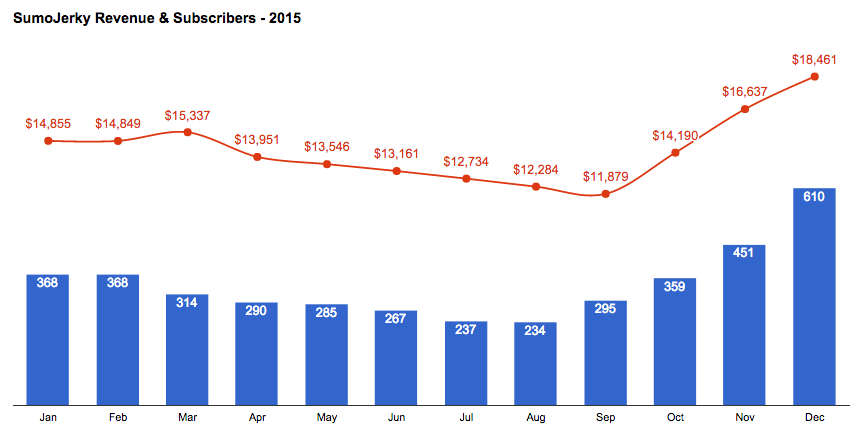
The following tactics are simple but may be out of your comfort zone if you’re used to more traditional marketing.
If you can push past the discomfort and follow the steps below you can easily double your business in three months. I’m rooting for you.
Step 1 – Get an email-based accountability partner
An email-based accountability partner is someone you email once a day who will reply back with small tidbits of encouragement and feedback. They also make sure that you KEEP emailing them once per day.
I’m a Meyers-Briggs INTJ all the way and prefer working alone. I rarely ask others for help or feedback. Since SumoJerky is bootstrapped and I’m the sole employee, I’ve historically only been accountable to myself. I like it that way.
And yet, I have to admit, getting an email accountability partner was one of the top drivers of SumoJerky’s turnaround in 2015. It’s a little difficult to parse out, but here’s my rough estimate:

It’s hard for me to understand why email-based accountability is so effective. It shouldn’t make a huge difference whether or not I exchange one line messages with someone on Gmail everyday — but it does.
If I had to speculate as to why email accountability helps, I’d say:
- Gives you a role model to impress / not disappoint.
- Brings you focus when distracted.
- Delivers criticism when deserved.
- Provides thought provoking ideas & advice.
- Shares connections / resources when necessary.
I was lucky and basically got offered email accountability by someone I respected and trusted. I didn’t have to ask around.
To find an email accountability partner, I’d recommend looking within your existing network and selecting for the following traits:
- You already trust their business insights and opinions.
- You are not BFF’s or family (too hard to be brutally honest w/ each other).
- They have rooting interest or financial ties to your biz.
This could be a supplier, a customer, an ex-coworker, an ex-boss, or a peer in a Facebook group. If you’re having trouble asking, here’s an email script that can work:
“I’ve been really impressed w/ what you’ve done w/ X and am trying to emulate your success. The one thing really holding me back is not having someone to hold me accountable.
Was thinking it would be smart to have an email accountability partner to whom I can send 1 short email per day w/ my results, etc.
Was wondering if you’d be willing?”
If you need to go outside your network, then Alex Turnbull from Groove has some great advice on how to find a mentor who can serve as your email accountability partner.
In terms of how to interact with your email accountability partner, here’s what worked for me:
- Email daily with a short summary of actions taken and results.
- Email anytime you need advice, have a big achievement/failure, feel stuck or unhappy.
- Meet quarterly in-person or Skype to reconnect and reset goals.
I don’t expect long replies from my email accountability partner. Here’s a typical interaction:
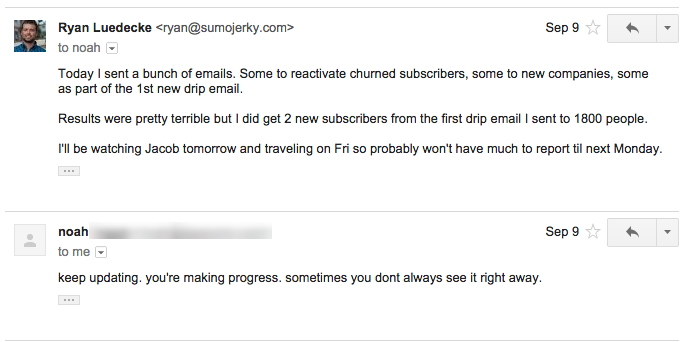
Sometimes I write to vent. Other times I need a reassuring pat on the back. Occasionally I’m looking for a specific tip, idea, or connection. 99% of our interactions are emails with the rare text message or in-person meetup sprinkled in.
Once you’ve found an email accountability partner, it’s time to pick the goal you want to accomplish.
Step 2 – Focus on 1 goal instead of multiple.
During 2014 I had two business goals: $100,000 monthly revenue for SumoJerky and $5,000 monthly revenue from coaching, mentorship, and digital products.
Each goal would have potentially been fine on its own but together they were a disaster. I was trying to grow SumoJerky, while trying to find people to mentor, while also trying to create an online course.
2 goals entered, no goals achieved.
2015 was even worse. I started with zero goals and was having disastrous results so I met with my email accountability partner who convinced me that setting one goal would help save SumoJerky.
Together we mapped out a S.M.A.R.T. plan to hit 400 paid subscribers.

After setting my 400 subscribers goal, anytime I faced a decision about how to prioritize my work, I simply asked myself, “is this the best possible thing I could do right now to help me reach 400 subscribers.”
This made every decision clear. There was less hesitation and more action. Since reaching my goal for 2015, I’ve followed my own advice and picked 1 goal again for 2016: 1500 paid subscribers.
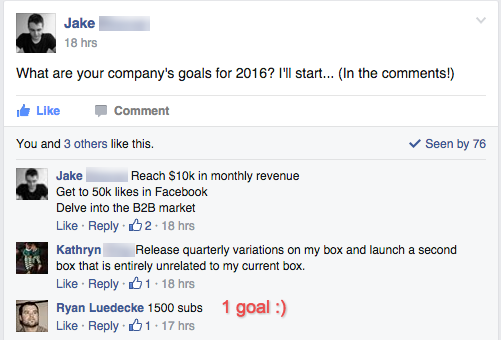
I’ve stopped chasing tons of different silver bullet growth ideas and prefer to focus on the simple tactics that are already working. One of those tactics is to collect my website visitors’ email first before going for the sale.
Step 3 – Collect your website visitor’s email BEFORE you go for the sale.
I’m not very good at designing websites, but I’m pretty good at writing emails.
I thought that if I could get someone’s email I’d have a better chance of persuading them to try SumoJerky.
With 3,000 website visits per month, I wanted 5-10% of those visitors to give me their email. That would provide a solid monthly pipeline of 150 to 300 leads to grow the business.
Having read stories about people using Sumo Welcome Mats to get email signups I figured I’d add one to my home page.
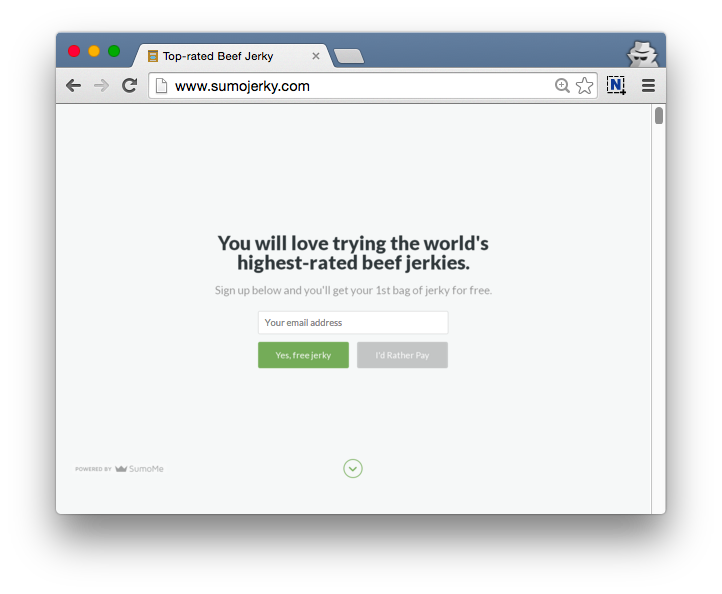
This turned out to be a great decision as my Welcome Mat now converts 9% of my web traffic to email signups. That gives me about 300 leads per month to work with.
Part of the success of the Welcome Mat is that I’m offering something free (read step 4), but the other driver of success is the design.
Sometimes I find it beneficial to copy what someone else does until I fully understand how a tool works. So if you want to setup your Welcome Mat design similar to mine, here are the steps.
- Sign up and install it for free here.
- Open Welcome Mat and set the Design template to Atomic with a white background.
- Make your signup offer compelling. Ideally, offer something free.
- Make your signup button color green with a benefit-driven call to action.
- Make your opt-out button lighter gray and clearly explain what happens if they opt out.
Once people sign up via the Welcome Mat, I have their email addresses auto-imported into MailChimp and added to my newsletter.
That’s it. If your sign up offer is compelling you should be able to convert at least 5% of your website traffic to email signups. Over the long term, you’ll want to adjust your design and test different settings to see if you can achieve even better results.
Step 4 – Give something valuable away for free, even when it seems impossible.
As I mentioned, using a Sumo Welcome Mat to offer a free bag of jerky ended up delivering a 9% conversion rate. That’s pretty great.
However, I haven’t always offered a free bag of jerky as I had a hard time making the numbers work.
The smallest SumoJerky subscription plan we offered in the past was 3 bags/per month and it cost me roughly $20 to send out a free trial. If I gave all new members a free trial I would have lost a lot of money.
Some people like to give away something digital to help cut free trial costs, but I didn’t think a free e-book or free beef jerky recipe would be very compelling to my target customer.
So I tried something else.
I created a 1 bag per month plan and added it to my signup page. From there, I created a coupon code for the first bag free if a new member would help me cover the <$4 shipping. That meant for a new member in the US, they’d receive a gourmet bag of beef jerky for $3.96. Not bad.
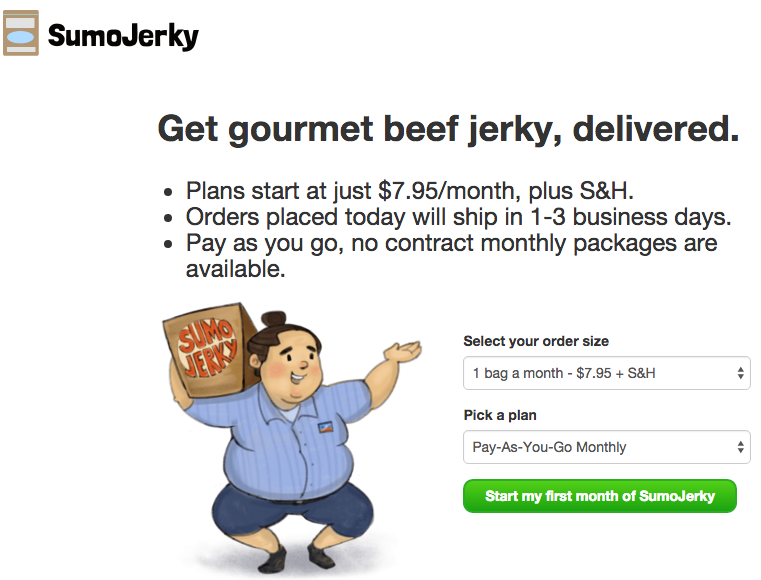
To be safe, I offered the free bag to about 100 people first and monitored how long they stayed members. I wanted to make sure I could recover my losses from the trial month if I gave away the free bag. Retention was strong enough to make the free bag promotion profitable so I made it a permanent offer in our signup flow.
Since 9% of people signed up to receive the free bag and then half those went on to subscribe and redeem the free bag, I had effectively achieved a 4.5% conversion rated to paid subscriptions. In other words, about 5 out of every 100 people who visited my site were now signing up for a paid subscription. That’s pretty good!
Now that people were signing up for SumoJerky I just had to figure out how to keep them. Automation is all the rage, but de-automating and personalizing has helped me retain my customers long-term.
Step 5 – De-automate some parts of the biz that experts say to automate.
With Sumo Welcome Mat set up and emails porting into MailChimp automatically, some experts might recommend automating everything. Just send subscribers a few drip emails and, voila, take their money and ship them their products.
I tried that in the past and it’s nice in the beginning, but then you get into a situation where something goes wrong, people start canceling and you’re left with no insights into what your customer really wanted, why they’re canceling now, and why they won’t reply to any of your emails.
I decided to try something different. It’s a hybrid approach that has some automated emails mixed in with some emails I personally send from my Gmail account.
When a customer signs up for a free bag of jerky, here’s what happens:
- Subscriber gets automated email that reiterates the free bag offer and asks the subscriber to reply YES if they want it.
- Subscriber replies YES and that goes to my personal email.
- I reply from Gmail asking for dietary restrictions and taste preferences.
- Subscriber replies back with taste preferences.
- I reply with a link to signup and a code for a free bag.
- Subscriber signs up.
- I customize the subscriber’s trial order to match preferences then personally write back to thank the subscriber.
This hybrid email series has a slew of benefits over strict automation.
Most importantly, it helps me build authentic relationships with members. I get to know their taste preferences. I often learn why they signed up. It makes me stand out from other businesses who don’t offer personal interaction and customization.
Later on, if something goes wrong for the customer during their membership, I already have a rapport established so they’re more willing to give me a second chance.
This personalized customer service has helped SumoJerky improve conversion and stabilize our retention rate at 87%.

This means about 87% of members will stay for next month’s box. According to Cratejoy, an e-commerce platform for subscription boxes (i.e. they actually have the data on this stuff) anything above 85% is considered good.
In addition to improving retention, I’ve found my email strategy makes customers much more willing to do kind things for me like refer friends and leave reviews.

Since personalizing my emails, I’ve had 35 subscribers refer their friends via email and 102 members leave 5-star products reviews. These little things help grow sales.
Conclusion
Seeing my business start to decline last year wasn’t easy. The numbers made it impossible to ignore.
There was a good amount of personal discomfort (i.e. admitting the need for help and using a pop up on my site) and manual labor involved in turning the business around and doubling the subscriber base. I was lucky that a good email accountability partner fell in my lap.
Once I had an accountability partner, I set myself 1 achievable goal.
For marketing, I set up a system that played to my strengths, using my website to get a customer’s email first rather than going straight for the sale.
From there, I figured out how to give a small part of my service away for free even when the initial numbers didn’t seem to work.
I kept my stack of online tools simple and my email communications with customers mostly de-automated. I used ultra-personalized customer support to help increase conversion, retention, referrals, and product reviews.
The result was that SumoJerky more than doubled its subscriber base and increased monthly recurring revenue by 155%. I’m confident you can do the same for your business.
Add A Comment
VIEW THE COMMENTS